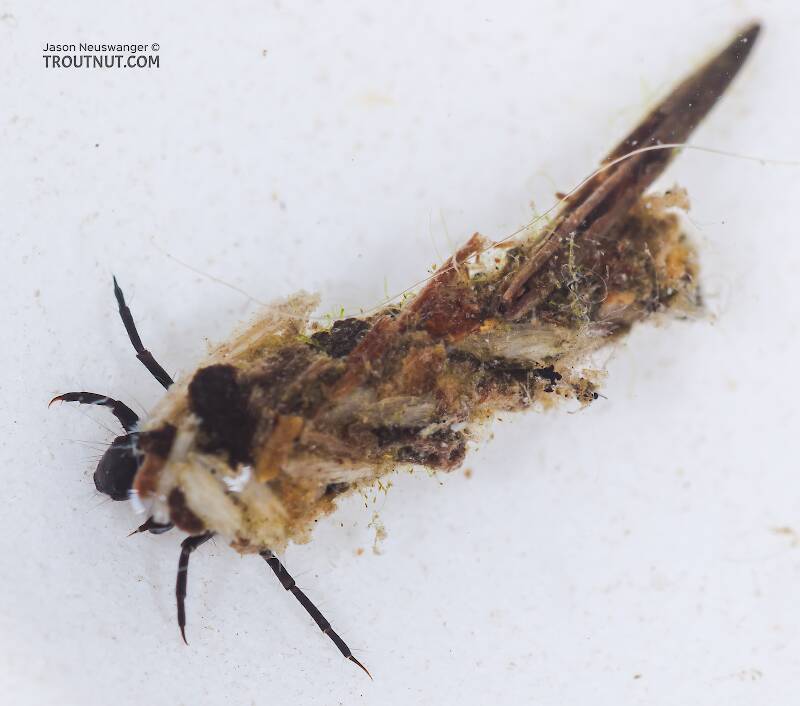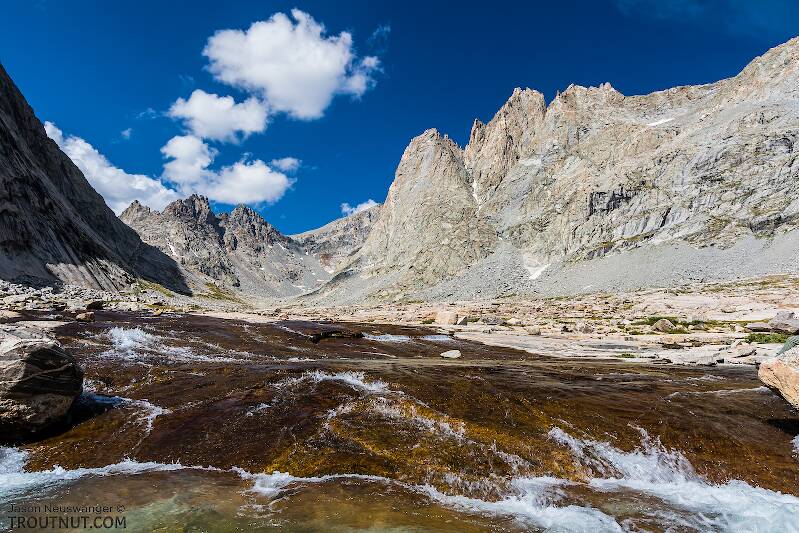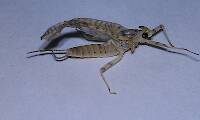
Hex Mayflies
Hexagenia limbata
The famous nocturnal Hex hatch of the Midwest (and a few other lucky locations) stirs to the surface mythically large brown trout that only touch streamers for the rest of the year.
Featured on the forum

This seems to be a young larva of Limnephilus. Although not clear in the picture, several ventral abdominal segments have chloride epithelia.

Troutnut is a project started in 2003 by salmonid ecologist Jason "Troutnut" Neuswanger to help anglers and
fly tyers unabashedly embrace the entomological side of the sport. Learn more about Troutnut or
support the project for an enhanced experience here.
Goose
Posts: 77
Posts: 77
Goose on Nov 13, 2006November 13th, 2006, 12:00 am EST
Is there a book of tying out there that shows actual photos of bugs in their nymphal stage, transitional dun stage, and adult stage? I would appreciate all suggestions. Thanks
Troutnut on Nov 13, 2006November 13th, 2006, 7:27 am EST
Depending on what you mean exactly, that could mean dozens of books or none of them. Could you explain what you're looking for in more detail?
Jason Neuswanger, Ph.D.
Troutnut and salmonid ecologist
Troutnut and salmonid ecologist
Goose
Posts: 77
Posts: 77
Goose on Nov 14, 2006November 14th, 2006, 12:20 am EST
Hi Jason! Sorry! I'm looking for a book that shows pictures of bugs as nymphs, emergers or transitional duns, and duns. For example, the New England Book of Hatches is excellent, but it doesn't have actual pictures of all stages of a mayfly or caddis fly. I'd like to have one that shows photos, for example, of a Sulfur Mayfly as a nymph, emerger and dun. I'd like to be able to identify bugs I find on the stream in Pennsylvania. I was fishing last Friday and I was turning over rocks and looking at the bugs as I do every trip. I been finding this nymph the past few weeks and I can't identify it and I haven't fished with anyone who is sure what it is. I was looking for the book as a learning tool. The bug I'm looking at has three tails, is a wide-bodied clinger-type nymph, and is kind of a mottled gray/brown color. I guess it's about a size 16. I know that's not much to go on. I took a picture of it, but I didn't have my glasses on and it's out of focus.
Martinlf on Nov 14, 2006November 14th, 2006, 1:20 am EST
Jason, how useful is Caucci's little Mayfly Identification Guide for the kind of question Goose posts here? I have a copy, but have never actually used it on the stream. There are some big nymphs in one particular stream that I plan to kick seine for again this year and to take the guide to make a positive ID if I can. I'm pretty sure they are Hendricksons, as I see the spinners every year, and so far don't know of any other larger mayflies that inhabit the stream, thogh I suppose they may be cahills of some sort. I know this is not the kind of book Goose is actually asking about, but I've always felt it might be a useful resource if I could get myself to carry it and a magnifier more frequently. It lived in my vest a while, but I was too busy fishing to use it, then it got moved out to make room for rain gear, and now I'll have to dig through an extra clothes bag, I think, to find it.
"He spread them a yard and a half. 'And every one that got away is this big.'"
--Fred Chappell
--Fred Chappell
Troutnut on Nov 14, 2006November 14th, 2006, 3:40 am EST
There aren't any books that show the nymph, emerger, and dun for every species. Capturing the emerger in action in a photo is really hard to do so there are precious few good emerger photos around, period, let alone for every species. Another thing you generally won't hear is just how common it is to find obscure species. I think at least a third of the mayflies I collect are from species rarely if ever seen in fly fishing books. When people try to identify them to species using keys in a fishing book, it usually just leads to frustration.
It sounds like your mystery nymph is in the Heptageniidae family but it's not Epeorus. If it's more brown than gray it's likely to be a Maccaffertium species, but that's a broad generalization. You might want to poke around the Heptageniidae section on this site and look for any nymphs that look similar.
Caucci and Nastasi's mayfly identification guide is probably the best streamside ID guide currently in print.
It sounds like your mystery nymph is in the Heptageniidae family but it's not Epeorus. If it's more brown than gray it's likely to be a Maccaffertium species, but that's a broad generalization. You might want to poke around the Heptageniidae section on this site and look for any nymphs that look similar.
Caucci and Nastasi's mayfly identification guide is probably the best streamside ID guide currently in print.
Jason Neuswanger, Ph.D.
Troutnut and salmonid ecologist
Troutnut and salmonid ecologist
Goose
Posts: 77
Posts: 77
Goose on Nov 14, 2006November 14th, 2006, 4:08 am EST
Thanks, Guys! I was surfing around and I came across this book: "An Angler's Guide To Aquatic Nymphs & Their Imitations: For All of North America." It's written by Rick Hafele and Schroeder. Are you aware of it?
Also, it was stupid of me to include photos of emergers. I realize it's very hard to get bugs in that phase.
Also, it was stupid of me to include photos of emergers. I realize it's very hard to get bugs in that phase.
Taxon on Nov 14, 2006November 14th, 2006, 8:51 am EST
Goose-
An Angler’s Guide to Aquatic Insects And Their Imitations by Rick Hafele and Scott Roederer, illustrated by Richard Bunse, is an excellent starter book on aquatic entomology. It is packed with information, has effective keys for identification to family level for both larval and adult life stages, and is compact enough to be conveniently taken into the field.
I would recommend this book as your first purchase. However, books covering multiple on aquatic insect orders (mayflies, caddisflies, stoneflies, true flies, dragonflies/damselflies, alderflies/dobsonflies, beetles, etc.), like this one, don't delve deeply enough for species level identification. Actually, I can only think of one such book that goes beyond family level identification to genus level identification, and it is far too technical for someone just starting out.
An Angler’s Guide to Aquatic Insects And Their Imitations by Rick Hafele and Scott Roederer, illustrated by Richard Bunse, is an excellent starter book on aquatic entomology. It is packed with information, has effective keys for identification to family level for both larval and adult life stages, and is compact enough to be conveniently taken into the field.
I would recommend this book as your first purchase. However, books covering multiple on aquatic insect orders (mayflies, caddisflies, stoneflies, true flies, dragonflies/damselflies, alderflies/dobsonflies, beetles, etc.), like this one, don't delve deeply enough for species level identification. Actually, I can only think of one such book that goes beyond family level identification to genus level identification, and it is far too technical for someone just starting out.
Quick Reply
Related Discussions
Topic
Replies
Last Reply
0
Jan 7, 2021
by Coha
by Coha
Re: Help obtaining photos of larval insects for a City of Denton, TX photographic key to ID'ing.
In the Identify This! Board by Rdjudy
In the Identify This! Board by Rdjudy
1
Jul 28, 2008
by Taxon
by Taxon
1
Oct 24, 2008
by Brookyman
by Brookyman
2
May 12, 2016
by Partsman
by Partsman





